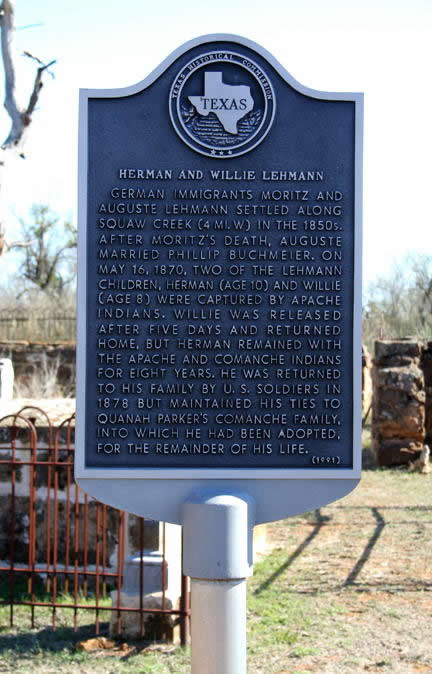|
Maurice
and Augusta Johanna Lehmann were German immigrants who met and married
in Texas in 1849; settling near what
would later become Loyal
Valley in Gillespie
County. In the Spring of 1859 they gave birth to their first son
and named him Herman. As they gazed down upon their cooing offspring
they must've wondered at his future. Doctor? Lawyer? Indian chief?
Imagine his mother's surprise when (eight years later) she found out
it was Indian chief.
German immigrants in mid 19th Century Texas didn't have it easy. Although
John Musebach
had had success with treaties between the settlers and the semi-nomadic
Comanches, still there were people who "didn't get the memo." There
were Comanche renegades, parties that didn't read the fine print,
parties that didn't bother to read the large print and then there
were the Apaches.
The Lehmanns had three other children, two girls and a boy named Willie.
Mr. Lehmann died in 1864 and Augusta soon found another husband /
father in Philipp Buchmeyer. I'd say that the children were playing
one spring day in 1870, but knowing they were German, they were probably
building rock walls, digging wells, milking deer or doing something
constructive. Suddenly, without warning, a group of Apaches (not Comanches)
swooped down on the defenseless group, capturing Herman and Willie,
and leaving the girls to explain to Mama why Willie and Herman weren't
at the dinner table.
Willie
managed to escape after a week or so and find his way home; but Herman's
odyssey was just beginning. Before he had had a chance to attend even
a single day of German school, Herman found himself suddenly enrolled
in the Apache school of hard knocks. He survived "Initiations for
German Settlers' Children," and managed to pass basic ASL (Apache
as a second language).
Herman's Indian mentor was a notorious Apache warrior known as Carnoviste,
and when Carnoviste wasn't busy killing settlers or rival Indians,
he instructed young Herman in all the lore that Apache boys needed
to become Apache men - which was mainly killing Comanches, Rangers,
Mexicans, and white settlers - in no particular order of preference.
Carnoviste died a warrior's death and Herman (who had grown pretty
tough by this time) got into an argument with another warrior. Apache
arguments often had fatal results and such was the case here. Herman
won, but the dead Indian happened to be a Medicine Man - which made
it a felony under Apache law. Herman decided to separate himself from
the tribe for awhile and free-lance - spending a year alone in West
Texas. (Even today mental health professionals can't agree on
the long-term effects of spending a year alone in West
Texas.)
On
his travels, Herman crossed trails with some Comanches. Although they
first recognized his Apache fashions and almost killed him, they also
noticied his third-degree sunburn. He joined up with them and his
new companions called him Montechena (which is Comanche or Spanish
for something). Among Spanish-speaking Indians he was known as Alemán
- or "German."
With his new companions, Herman fought the United States Cavalry and
their allies, the Tonkawa.
He was captured and interred with Comanches at Fort Sill and is said
to have been adopted by none other than the famous Chief
Quanah Parker. His European features and fair skin gave him away
and he was sent back to Texas to be reunited
with his original family. He arrived in Gillespie
County in May of 1878 - almost exactly eight years to the day
that he was captured.
Herman's
reentry into "polite" society had its rough spots. Eating family pets,
refusing sauerkraut, and chanting when everybody else was trying to
get some sleep tried everyone's patience. Little brother Willie, who
must've been thinking "Aber für die Anmut des Gottes, gehen Ich,"
tried his best to explain to Herman that killing the neighbors' livestock
was frowned upon. Willie also coached Herman in German and generally
kept a protective eye on his older brother.
Since there were no state-run halfway houses for former captives,
Herman lived with his family at his mother's boarding house. He prefered
wearing his Indian regalia and frequently appeared at meals wearing
little else but paint and feathers. Guests either found Herman's habits
amusing or found other lodging.
Herman finally got around to enrolling in school. As soon as he realized
his credits for life-experience didn't transfer, he immediately left.
He longed to do what he was good at, but with killing now out of the
question, he tried his hand at odd jobs - including signing on as
a cowboy on a trail drive to Kansas. |
 |
Herman
finally settled down for good at Loyal
Valley. He was said to have had a sense of humor and he certainly
enjoyed his celebrity status. - which was [probably] curtailed when
he married Miss Fannie Light in 1890. Since his last employment as
an Indian was as a Comanche; he became eligible for an Oklahoma land
grant. He and Fannie had five children and spent their lives between
their home in Oklahoma with frequent visits to Texas.
Hermann posed for the portrait (above) during a 1928 Trail-Rider's
Convention in San Antonio.
He died in 1932 and is buried in the Loyal
Valley cemetery. |
Forum:
Subject:
Uncle Herman Lehmann
Good Morning: I want to take a moment this morning to thank you
for the hilarious – and vivid – stories that you have published
about our Uncle Herman. I believe I speak for our whole family when
I say that you really have captured his eccentric nature. I was
wondering, however, why there was no mention of the Cherry Hills
Dance Hall in your account of his various occupations…especially
considering the importance “Honky Tonks” have played in Texas history.
Thanks again! - Kimberley Holcomb, October 16, 2012
|
|
|
